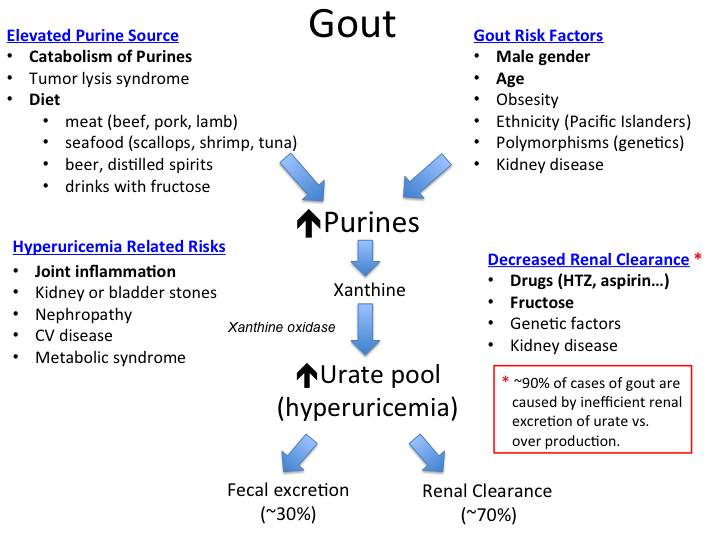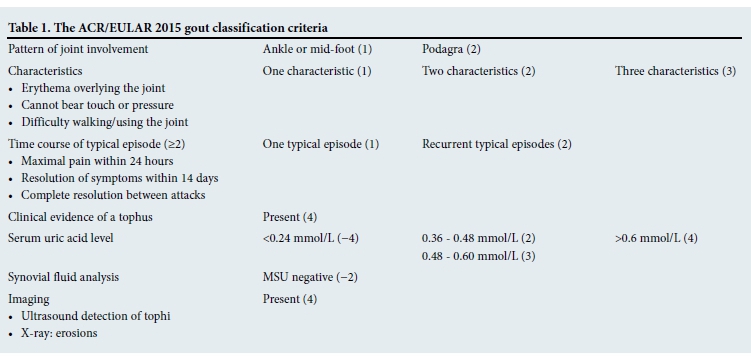Gout, a form of inflammatory arthritis, is caused by elevated levels of uric acid in the blood, a condition known as hyperuricemia. This buildup of uric acid leads to the formation of sharp crystals in a joint, causing sudden and severe episodes of pain, swelling, redness, and tenderness. While gout can affect anyone, it is more common in men and postmenopausal women. Understanding its causes, recognizing its symptoms, getting an accurate diagnosis, and following effective treatment strategies are essential for managing this painful condition.

What Causes Gout?
Gout occurs when there is an excess of uric acid in the body, which can result from either overproduction or underexcretion of uric acid. Uric acid is a waste product formed when the body breaks down purines, substances found naturally in the body and in certain foods. Several factors contribute to the development of gout:
Dietary Factors
- Consumption of foods high in purines, such as red meat, organ meats, shellfish, and certain types of fish, can increase uric acid levels.
- Excessive intake of sugary beverages and alcohol, particularly beer and spirits, has been linked to higher risks of gout.
Medical Conditions
- Obesity increases the risk of gout because more tissue means more uric acid production.
- Kidney disease can impair the body’s ability to eliminate uric acid efficiently.
- Certain metabolic disorders, such as diabetes and high blood pressure, are associated with gout.
Genetic Predisposition
Some people inherit a higher tendency to develop gout due to genetic factors that affect how their bodies handle uric acid.
Medications
- Diuretics, commonly prescribed for high blood pressure and heart failure, can reduce the excretion of uric acid.
- Low-dose aspirin and certain immunosuppressants may also contribute to elevated uric acid levels.
Symptoms of Gout
The hallmark symptom of gout is sudden and intense pain in a joint, often occurring at night. The most commonly affected joint is the big toe, but gout can also impact other joints, including the ankles, knees, elbows, wrists, and fingers. Key symptoms include:
Joint Pain
The pain is usually severe and peaks within 12 to 24 hours after onset. Even the slightest touch or pressure on the affected joint can cause significant discomfort.
Swelling and Redness
The affected joint often becomes swollen, tender, and warm to the touch. The skin around the joint may appear red or purple.
Limited Range of Motion
As gout progresses, repeated attacks can lead to joint damage, making it difficult to move the joint normally.
Tophi Formation
In chronic cases, hard lumps called tophi may form under the skin near joints or in soft tissues. These deposits consist of uric acid crystals and can cause permanent damage if left untreated.
Diagnosing Gout
Diagnosing gout involves a combination of clinical evaluation, medical history, and laboratory tests. A healthcare provider will assess the patient’s symptoms and perform specific tests to confirm the presence of uric acid crystals in the affected joint.
Physical Examination
A doctor will examine the affected joint for signs of inflammation, such as swelling, warmth, and redness. They will also inquire about the pattern and duration of symptoms.
Joint Fluid Analysis
This test involves extracting fluid from the inflamed joint using a needle. The fluid is then examined under a microscope to check for the presence of uric acid crystals, which are a definitive indicator of gout.
Blood Tests
Blood tests measure the level of uric acid in the bloodstream. However, high uric acid levels alone do not confirm gout, as some individuals with elevated levels never develop symptoms, while others with normal levels may experience gout attacks.
Imaging Tests
X-rays, ultrasounds, or dual-energy CT scans may be used to detect joint damage or the presence of uric acid crystals in advanced cases.
Treatment Options for Gout
The primary goals of treating gout are to relieve acute symptoms, prevent future attacks, and reduce the risk of complications such as joint damage and kidney stones. Treatment typically involves medications, lifestyle changes, and dietary modifications.
Medications for Acute Attacks
- Nonsteroidal Anti-Inflammatory Drugs (NSAIDs): These medications help reduce pain and inflammation during an acute attack. Common examples include ibuprofen and naproxen.
- Colchicine: This anti-inflammatory drug is specifically effective for gout and works best when taken early in an attack.
- Corticosteroids: In cases where NSAIDs or colchicine are not suitable, corticosteroids such as prednisone may be prescribed to control inflammation and pain.
Long-Term Medications to Prevent Future Attacks
- Urate-Lowering Therapy: Medications like allopurinol and febuxostat work by reducing the production of uric acid in the body.
- Uricosuric Agents: Drugs such as probenecid help the kidneys excrete more uric acid, thereby lowering its concentration in the blood.
Lifestyle and Dietary Changes
- Maintain a healthy weight through regular exercise and a balanced diet.
- Limit consumption of purine-rich foods, sugary drinks, and alcohol.
- Stay hydrated by drinking plenty of water to help flush out uric acid.
- Increase intake of low-fat dairy products, vegetables, and whole grains.
Monitoring and Follow-Up
Regular monitoring of uric acid levels is crucial for individuals with gout. Adjustments to medication dosages may be necessary to achieve target levels and prevent complications. Patients should also report any new symptoms or side effects to their healthcare provider promptly.
Complications of Untreated Gout
If left untreated, gout can lead to several serious complications, including:
Chronic Gout
Repeated gout attacks can cause persistent joint pain and stiffness, eventually leading to joint deformity and loss of function.
Kidney Stones
High levels of uric acid can lead to the formation of kidney stones, which can cause severe pain and urinary problems.
Gouty Arthritis
Prolonged inflammation can damage cartilage and bone, resulting in chronic arthritis that is difficult to manage.
Tophaceous Gout
The accumulation of uric acid crystals in soft tissues can lead to the formation of large, disfiguring nodules called tophi, which may ulcerate and become infected.
Preventing Gout Attacks
While not all cases of gout can be prevented, adopting certain habits can significantly reduce the frequency and severity of attacks:
- Follow a gout-friendly diet that limits purine-rich foods and emphasizes plant-based proteins.
- Avoid binge drinking and excessive alcohol consumption.
- Exercise regularly to maintain a healthy weight and improve overall health.
- Take prescribed medications consistently and attend follow-up appointments as recommended.





